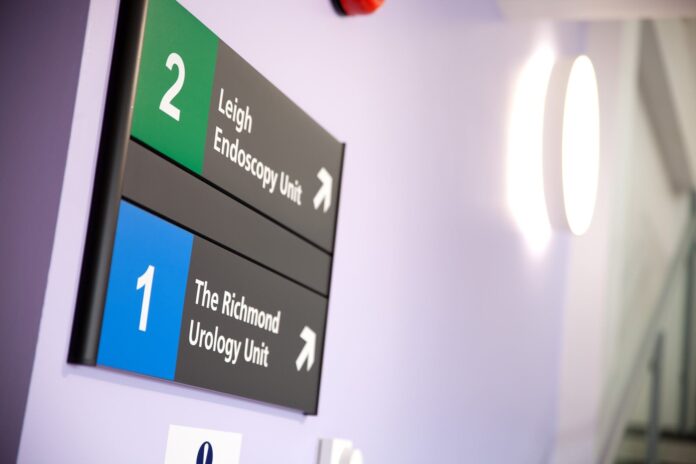Healthcare settings are full of different types of signage, from directional signs to health and safety recommendations. The various messages must be clear and simple yet informative to keep the patients informed and positive about their experiences.
Printed VS Digital Signage
Within most healthcare settings, printed signage is the most popular form of signage as it is cheap, easy to install and easy to maintain. However, as providers embrace the digital age there has been a rise in digital signage. Digital signage is becoming more affordable and effective therefore is an increasingly popular upgrade for hospitals.
Printed signage is traditionally for simple, static messages such as directions, healthcare posters and health and safety protocols. In places such as clinics or busy departments, digital signage can be employed to display evolving messages such as department wait times, health news updates, reminder messages or even entertainment.
In what ways is signage used in hospital settings?
If you consider the user experience, their journey generally starts in the car park as they enter. Many hospitals have certain parking areas for different departments so having a clear direction board as close to the entrance but at a safe distance from the road is key. Equally, if there are designated staff-only parking spaces then these need to be signposted as clearly as possible to avoid confusion and spaces being taken up incorrectly.
If there is a national or regional health drive, the type of signage used will be different. For example, as flu season approaches you may want to commission some roller banners to stand in key locations and departments and remind people that you can get free boosters if you are eligible. This is an effective way of making sure people remember to get their flu vaccines.
Hospitals can be huge spaces, so directional signage either overhead or on a large board inside is paramount. By clearly marking the entrances, exits, key departments and any amenities such as a café or lift, the stress level of the patient will be reduced and help to keep departments running on time rather than chasing after lost people.
In certain departments, having a digital screen displaying waiting times would be very helpful. If a patient is sat in a blood test clinic, having a rough waiting time will prevent them from getting agitated about how long they have been waiting. As much as these screens can be informative, you may wish to have entertainment on them as well, such as the news headlines or the weather.
Safety protocols need to be displayed clearly so that everyone visiting knows what is expected of them. If a one-way system is in place it may be worth doubling the signage to include stickers on the floor as well as the walls or hanging overhead. Having bright signage above hand washing stations is helpful as the bright colours draw the eye in and remind people to follow the hygiene rules.
Read Also
- Management Reinforcement for Healthcare Providers in a Shifting SystemHealthcare is changing faster than ever. So, providers are feeling the pressure to keep up. New technology, changing patient needs, and constant rule updates make it tough for managers to stay on top. Strong leadership helps teams work better, give great care, and stay happy in their jobs. Here’s how healthcare leaders can strengthen their… Read more: Management Reinforcement for Healthcare Providers in a Shifting System
- Why Effective Disinfection Remains the Foundation of Public HealthFrom hospitals and schools to transport hubs and food production sites, disinfection is central to breaking the chain of infection and protecting community health. The COVID-19 pandemic highlighted how crucial surface hygiene and environmental control are in reducing the spread of harmful microorganisms. Yet, beyond emergency response, routine and validated disinfection practices remain the cornerstone… Read more: Why Effective Disinfection Remains the Foundation of Public Health
- How to Navigate Your Medical Assistant Career PathBecoming a medical assistant can feel both exciting and a little stressful. This job lets you work closely with doctors and other healthcare workers to help patients. But with so many different paths to take, it can be hard to know where to start or how to plan your career. Wouldn’t it be nice to… Read more: How to Navigate Your Medical Assistant Career Path
- Benefits of Enrolling in Botox Training CoursesMany people want to enhance their skills in the beauty field, and one way to do that is through Botox training. With the rising popularity of Botox, enrolling in training courses can set you on a path to a rewarding career. If you are considering this option, you might be curious about the benefits that… Read more: Benefits of Enrolling in Botox Training Courses
- How Pilates Certification Enhances Professional Growth in HealthcareAre you looking for a way to expand your skills and stand out in healthcare? Pilates certification can be a powerful step in your professional journey. It not only helps you understand movement and body mechanics. It also gives you tools to support patient recovery. It also improves mobility, and promotes wellness. Ready to see… Read more: How Pilates Certification Enhances Professional Growth in Healthcare
- Understanding the Legality & Challenges in the Dental Aligner IndustryThe dental aligner industry has grown quickly in the past decade. More people are choosing clear aligners instead of traditional braces because they are less noticeable and often more convenient. While this growth has created new opportunities, it has also raised legal questions and practical challenges. Patients, dentists, and companies are still learning how to… Read more: Understanding the Legality & Challenges in the Dental Aligner Industry







